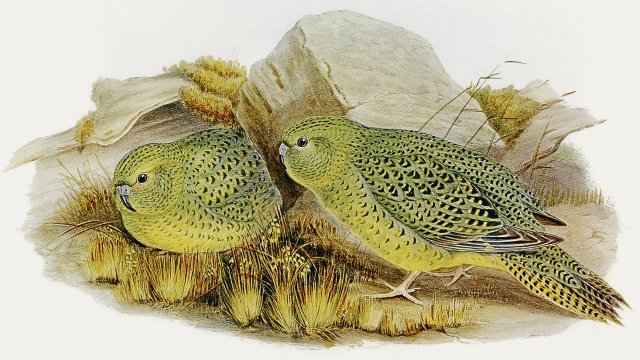The shy night parakeet has only been photographed a few times so far.
Foto: Elizabeth Gould
Who doesn’t know Australia’s unique iconic animals like koalas or kangaroos? However, many Australian animal species are already extinct, such as the legendary Tasmanian tiger. However, sometimes those who are said to be dead live longer, as the extremely rare night parakeet proves. It is considered one of the most mysterious birds in the world. The only other nocturnal parrot species in the world is the Kakapo, which lives in New Zealand.
The shy night parakeet (Pezoporus occidentalis) has not been seen Down Under since 1912. But since 1979 there have been reports again from people who claimed to have spotted the 22 to 25 centimeter long bird with its green plumage decorated with black dots. The scientific hunt for the night parrot really gained momentum after doctoral student Nicholas Leseberg from the University of Queensland took what was believed to be the first photo in the wild in 2016. Leseberg was subsequently able to prove that around 20 specimens still lived in Queensland.
More than 2,200 kilometers further west, Aboriginal gamekeepers in the Ngururrpa Indigenous Reserve in Western Australia took not only the second photo of a night parakeet in the wild in 2018. Together with scientists led by Leseberg, they discovered a colony of around 50 night parrots through observation, camera traps and acoustic recordings. That’s according to the rangers and scientists in their paper published in the specialist magazine “Wildlife Research” in September 2024 Studythe largest known population anywhere.
The nocturnal parrot sees poorly.
One of the many questions about the bird, which has hardly been described scientifically, is how so many of this species were able to survive in the remote outback. The astonishing assumption of the authors of the study: The cause lies in the encounter between the dingoes that have lived in Australia for thousands of years and the cats that were first introduced and made feral by white settlers. Studies of dingo feces have shown that poultry is not high on the wild dog’s menu. Dingoes (Canis dingo) were the predator species most frequently detected in the sleeping habitats of nocturnal parrots. Wild cats, in turn, turned out to be the dingo’s main prey in these habitats, the researchers report. Bushfires, which are not uncommon in Australia, are much more dangerous than predators. »One of the biggest threats to roosting and nesting sites is fire. (…) Fires during the breeding season would be particularly devastating,” emphasize the scientists.
Ngururrpa ranger Clifford Sunfly is proud of Indigenous people’s contribution to modern research. The indigenous rangers and scientists would learn from each other, Sunfly said. “The traditional way is to read the land,” says Sunfly, adding, “We also use technology to scientifically search for nests and protect their area from cats, camels and bushfires.”
The Ngururrpa protected area was previously isolated from the rest of the world in the deepest Western Australian outback. Now the region is set for change with plans to extract an estimated 123 million tonnes of potassium sulphate, or potash, from the Mackay Lake salt flat. To transport the potash, the mining company Agrimin is planning a 350 kilometer long private road to the port of Wyndham.
Surprisingly, there are no objections to the project from the local indigenous population. A contract was concluded with Agrimin that involves the local population in the project and at the same time guarantees their traditions as well as the protection of night parrots and other endangered species such as bandicoots. One point of the agreement: The road can only be used by the company’s trucks and the Aborigines, and only during the day. However, the street remains taboo for tourists.
Hopefully this will allow the night parakeets to live undisturbed in their nests in the dense spinifex grass and the scientists to be able to observe the lives of the previously largely unexplored birds in peace. However, biologist Vera Weisbecker from Flinders University in Adelaide discovered something surprising when examining a dead bird in 2020: the nocturnal parrot sees poorly.
Subscribe to the “nd”

Being left is complicated.
We keep track!
With our digital promotional subscription you can read all issues of »nd« digitally (nd.App or nd.Epaper) for little money at home or on the go.
Subscribe now!
sbobetsbobet88judi bola sbobetsbobet88judi bola judi bola link sbobet
